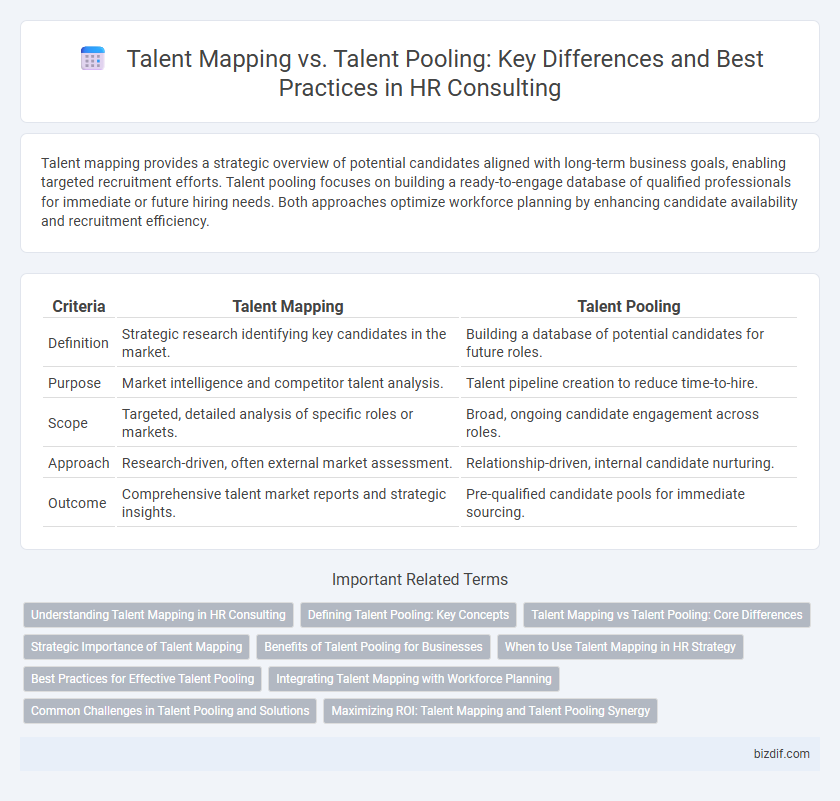Talent mapping provides a strategic overview of potential candidates aligned with long-term business goals, enabling targeted recruitment efforts. Talent pooling focuses on building a ready-to-engage database of qualified professionals for immediate or future hiring needs. Both approaches optimize workforce planning by enhancing candidate availability and recruitment efficiency.
Table of Comparison
| Criteria | Talent Mapping | Talent Pooling |
|---|---|---|
| Definition | Strategic research identifying key candidates in the market. | Building a database of potential candidates for future roles. |
| Purpose | Market intelligence and competitor talent analysis. | Talent pipeline creation to reduce time-to-hire. |
| Scope | Targeted, detailed analysis of specific roles or markets. | Broad, ongoing candidate engagement across roles. |
| Approach | Research-driven, often external market assessment. | Relationship-driven, internal candidate nurturing. |
| Outcome | Comprehensive talent market reports and strategic insights. | Pre-qualified candidate pools for immediate sourcing. |
Understanding Talent Mapping in HR Consulting
Talent mapping in HR consulting involves a strategic process of identifying, assessing, and forecasting talent availability within specific industries or roles to align with future organizational needs. This approach provides detailed insights into competitor talent landscapes, skill gaps, and potential candidates' career trajectories, enabling precise workforce planning. Unlike talent pooling, which maintains a broad database of potential hires, talent mapping offers a targeted, data-driven analysis crucial for long-term talent acquisition strategies.
Defining Talent Pooling: Key Concepts
Talent pooling involves creating a curated database of potential candidates who have been identified based on skills, experience, and cultural fit for current or future roles, enabling faster and more efficient recruitment. It helps HR teams maintain ongoing engagement with qualified candidates, reducing time-to-hire and improving talent acquisition strategies. By continuously updating and nurturing this talent repository, organizations can respond proactively to workforce demands and skill shortages.
Talent Mapping vs Talent Pooling: Core Differences
Talent mapping involves systematically identifying and analyzing potential candidates in the market to create a strategic talent pipeline aligned with organizational goals, while talent pooling gathers a broader group of potential candidates based on general skills or job categories for future hiring needs. Talent mapping offers a proactive, targeted approach by focusing on key roles and competitor analysis, whereas talent pooling provides a reactive, cost-effective resource for immediate recruitment demands. Understanding these core differences enables HR professionals to optimize talent acquisition strategies by balancing long-term workforce planning with short-term hiring flexibility.
Strategic Importance of Talent Mapping
Talent mapping provides organizations with a comprehensive, strategic overview of current and future workforce capabilities, enabling precise alignment with long-term business goals. This proactive approach identifies skill gaps, anticipates talent shortages, and supports succession planning more effectively than talent pooling. By leveraging data-driven insights, talent mapping enhances competitive advantage through targeted recruitment and optimized talent management.
Benefits of Talent Pooling for Businesses
Talent pooling enables businesses to build a ready database of qualified candidates, reducing time-to-hire and recruitment costs. It enhances workforce planning by providing immediate access to pre-screened talent aligned with company needs and culture. Continuous engagement with talent pools improves candidate experience and strengthens employer branding, driving higher retention and faster onboarding.
When to Use Talent Mapping in HR Strategy
Talent mapping is essential when organizations need a strategic overview of the talent landscape to identify skill gaps, forecast workforce needs, and align hiring plans with long-term business goals. It is ideal during market expansion, organizational restructuring, or leadership succession planning to proactively source high-potential candidates and reduce time-to-hire. Talent mapping provides critical insights into competitor talent, salary benchmarks, and candidate availability, ensuring a targeted and efficient recruitment strategy.
Best Practices for Effective Talent Pooling
Effective talent pooling involves continuous engagement, personalized communication, and regular updating of candidate information to maintain a dynamic and accessible talent database. Leveraging data analytics and AI-driven tools enhances the accuracy of talent mapping, enabling precise identification of skills and potential future roles within the talent pool. Integrating talent pooling with strategic workforce planning ensures alignment with organizational goals and improves talent acquisition efficiency.
Integrating Talent Mapping with Workforce Planning
Integrating talent mapping with workforce planning enables organizations to strategically identify critical skill gaps and forecast future hiring needs with precision. Talent mapping provides a detailed analysis of current talent capabilities and potential candidates, while workforce planning aligns these insights with business objectives and growth projections. This synergy enhances proactive recruitment, reduces time-to-hire, and ensures a well-prepared talent pipeline that supports long-term organizational success.
Common Challenges in Talent Pooling and Solutions
Talent pooling often faces challenges such as maintaining updated candidate information, ensuring engagement over time, and effectively segmenting talent to match evolving business needs. Solutions include leveraging AI-driven platforms for real-time data updates, implementing personalized communication strategies to nurture relationships, and using advanced analytics to categorize candidates by skills, experience, and potential fit. Addressing these issues enhances the accuracy and responsiveness of talent pools, resulting in more efficient recruitment processes.
Maximizing ROI: Talent Mapping and Talent Pooling Synergy
Talent mapping identifies high-potential candidates aligned with strategic business goals, enabling precise workforce planning and reducing hiring costs by targeting the right talent segments. Talent pooling organizes and nurtures a pre-qualified, engaged candidate database, accelerating time-to-fill and improving quality of hire by maintaining ongoing relationships. Combining talent mapping with talent pooling creates a dynamic recruitment ecosystem that maximizes ROI through targeted sourcing, reduced churn, and enhanced candidate experience.
Talent Mapping vs Talent Pooling Infographic

 bizdif.com
bizdif.com